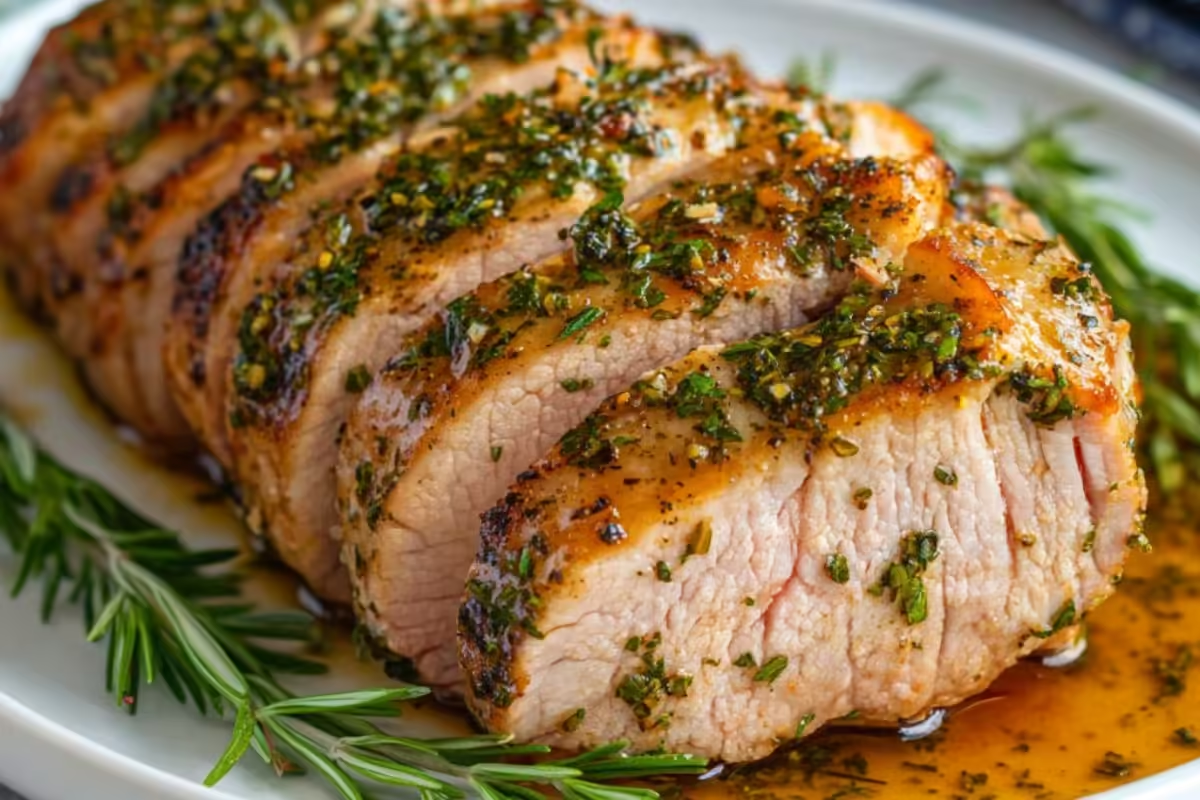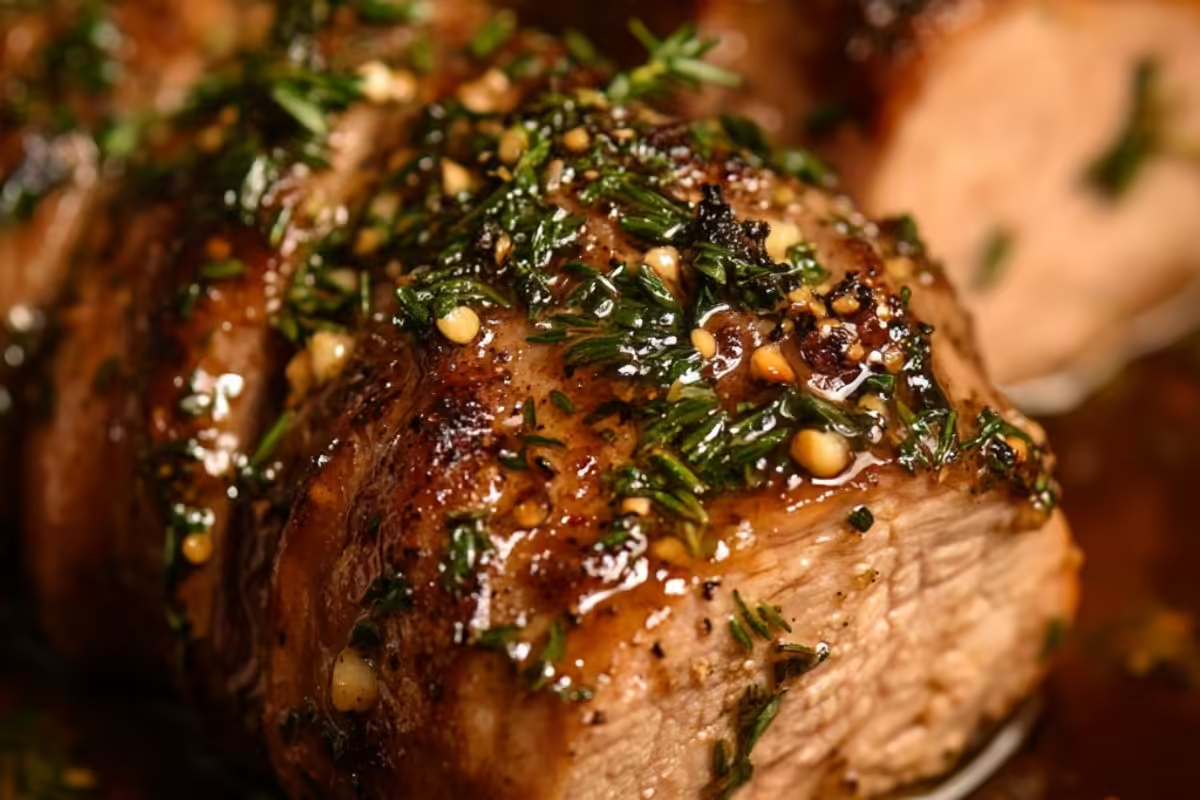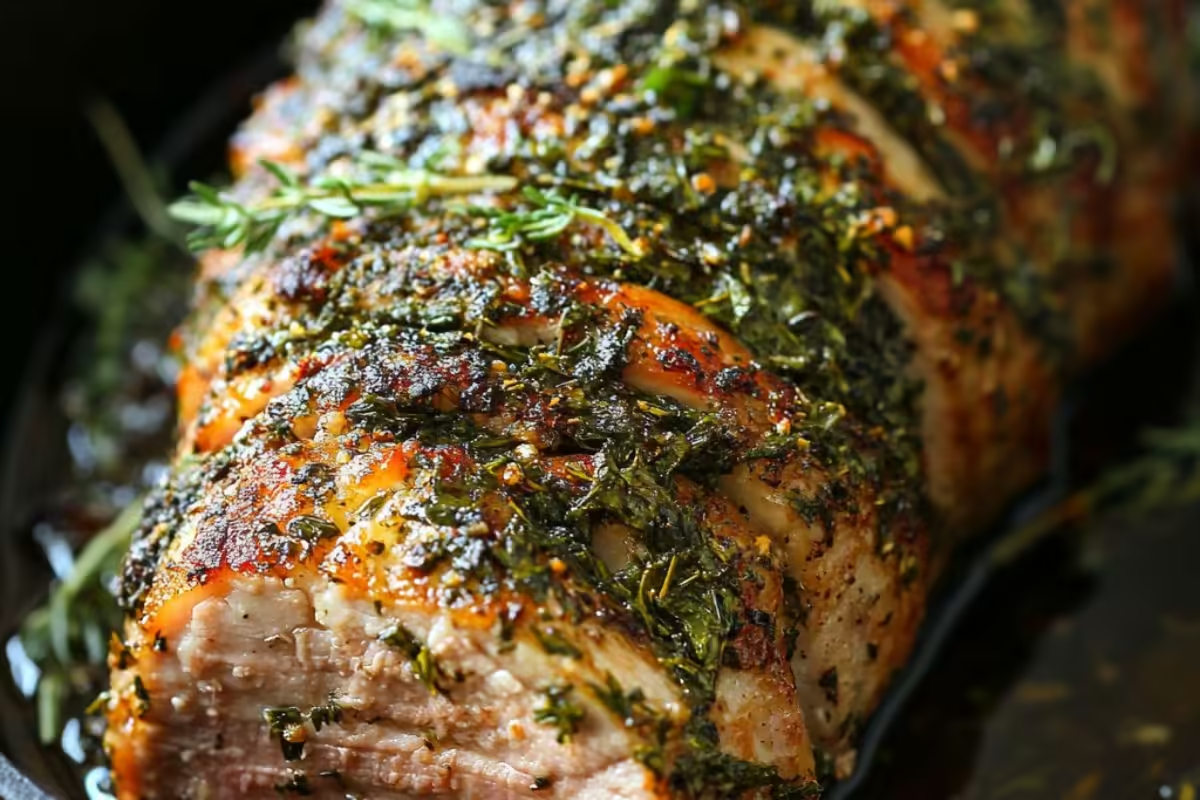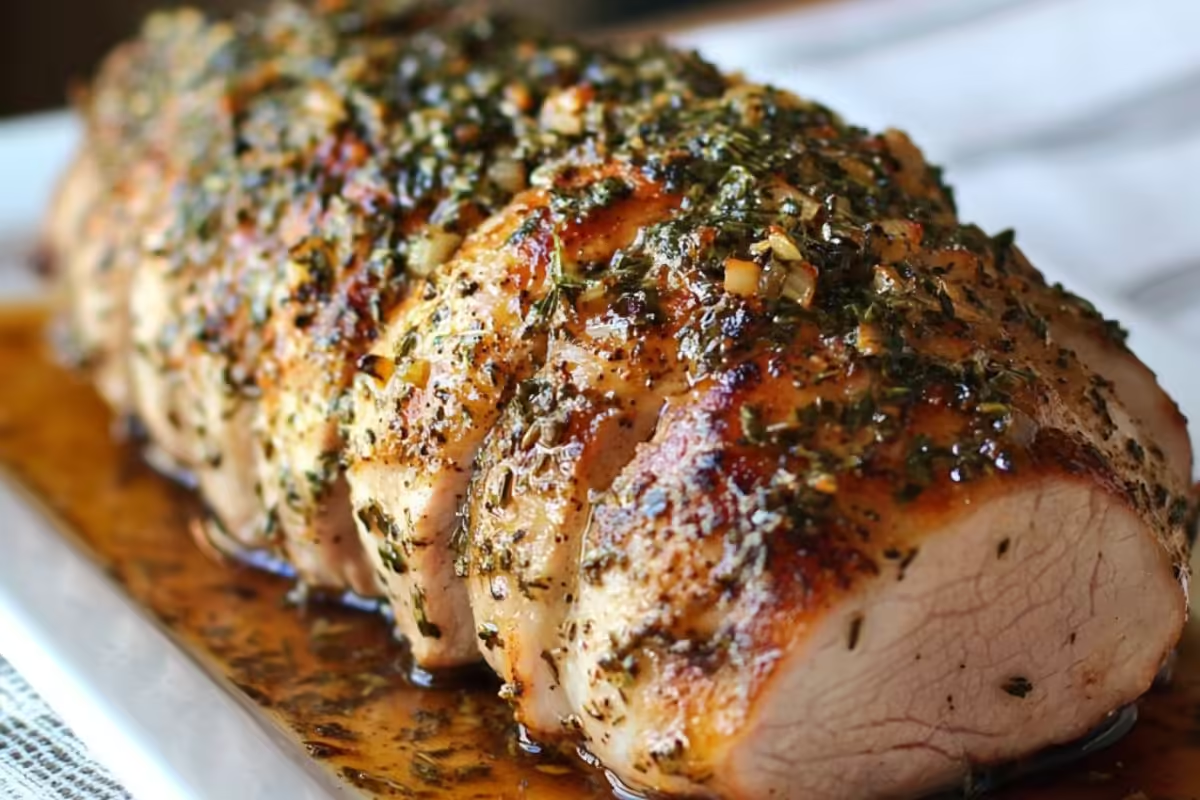When it comes to creating a memorable meal, juicy roasted pork tenderloin with herb marinade is a dish that ticks all the right boxes. Pork tenderloin is one of the leanest and most tender cuts of pork, making it ideal for a family dinner, a special occasion, or a casual get-together. The key to a perfectly roasted pork tenderloin is the marinade, which not only infuses flavor but also helps keep the meat moist during cooking. In this article, we will take you step by step through preparing, marinating, and roasting this delicious dish.
Whether you’re a seasoned cook or new to the kitchen, this guide will give you everything you need to master juicy roasted pork tenderloin and impress your guests.
 Why Pork Tenderloin is Perfect for Roasting
Why Pork Tenderloin is Perfect for Roasting
Pork tenderloin is the leanest cut of pork, making it a healthy choice for those looking for a high-protein, low-fat option. According to the National Pork Board, pork tenderloin is as lean as a skinless chicken breast, yet it offers a more luxurious and tender texture. This makes it an excellent option for anyone who wants a flavorful, healthy, and relatively low-calorie protein.
Another advantage of pork tenderloin is its versatility. It absorbs marinades well, allowing you to experiment with different flavors and styles of cooking. Whether you want something sweet, savory, spicy, or herby, pork tenderloin adapts to a wide range of seasonings and cooking methods.
One of the most popular and effective ways to cook pork tenderloin is by roasting it after marinating in an herb-based marinade. The herbs, garlic, and lemon work together to enhance the natural flavor of the pork, while the olive oil keeps the meat moist. Marinating also helps tenderize the meat, ensuring that the pork remains juicy even after roasting.
The Importance of Marinating Pork Tenderloin
Marinating is a critical step in preparing pork tenderloin, particularly when you want to achieve maximum flavor and tenderness. A well-crafted herb marinade is more than just a flavor enhancer—it also helps break down the muscle fibers in the pork, making it more tender and moist. The acidity from the lemon juice in the marinade plays an essential role in this process, as it helps to break down the proteins in the meat.
Additionally, the olive oil in the marinade serves two purposes. First, it adds richness and helps distribute the flavors evenly over the pork. Second, it locks moisture into the meat, preventing it from drying out during roasting. The herbs—like rosemary and thyme—add earthy, aromatic notes that perfectly complement the pork, while garlic provides a pungent, savory element that balances the marinade.
For those looking to get the most out of marinating, it’s ideal to let the pork sit in the marinade for at least 3 hours. For deeper flavor, marinate the pork overnight in the refrigerator.
Ingredients for the Perfect Herb Marinade
Creating a herb marinade for pork tenderloin is simple, but using the right ingredients makes all the difference. Here’s what you’ll need for this juicy roasted pork tenderloin:
Marinade Ingredients:
- 2 pork tenderloins (about 1 pound each)
- 1/3 cup olive oil
- Zest and juice of 1 lemon
- 4 garlic cloves, minced
- 2 tablespoons fresh rosemary, chopped
- 2 tablespoons fresh thyme, chopped
- 1 tablespoon Dijon mustard
- Salt and freshly ground black pepper, to taste
Ingredient Breakdown:
- Olive oil: Helps keep the pork tender during roasting and distributes the flavors evenly.
- Lemon juice and zest: The acidity of the lemon juice helps tenderize the pork, while the zest adds a bright, zesty note.
- Garlic: Minced garlic provides a rich, savory depth to the marinade.
- Rosemary and thyme: These fresh herbs add earthy and aromatic flavors, which are perfect for complementing the pork’s natural sweetness.
- Dijon mustard: Adds a slight tang that works well with the herbs and garlic.
- Salt and pepper: Essential for bringing out the flavors of the pork and the marinade.
For more inspiration on working with marinades, especially when cooking other meats like ground beef, you can explore this useful guide on ground beef recipes. While focused on beef, the principles of marination and flavor infusion apply equally to pork tenderloin.
Step-by-Step Guide to Preparing and Marinating Pork Tenderloin
Step 1: Trimming the Pork Tenderloin
Before marinating the pork, it’s essential to trim any excess fat or silver skin from the tenderloin. Silver skin is a thin, tough layer of connective tissue that doesn’t break down during cooking, and removing it will make the pork more tender. Use a sharp knife to carefully cut away this membrane without removing too much meat.
Step 2: Preparing the Marinade
In a medium-sized mixing bowl, whisk together the olive oil, lemon juice, lemon zest, garlic, rosemary, thyme, Dijon mustard, salt, and pepper. Stir the ingredients until they are well combined, ensuring that the flavors are evenly distributed.
Step 3: Marinating the Pork
Place the pork tenderloins in a resealable plastic bag or a shallow dish. Pour the marinade over the pork, ensuring that it is fully coated on all sides. If using a resealable bag, press out as much air as possible before sealing it, which allows the marinade to come into close contact with the pork. Refrigerate the pork for at least 3 hours, but for the best flavor, let it marinate overnight.
Marinating overnight allows the flavors to fully penetrate the meat, resulting in a more intense and flavorful dish. This long marinating time also helps to tenderize the pork, ensuring that it stays moist and juicy during cooking.
Searing and Roasting the Pork Tenderloin
Once the pork has marinated for several hours, it’s time to prepare it for roasting. To ensure that the pork is juicy on the inside and has a beautifully browned crust on the outside, it’s important to start by searing the meat before roasting.
Step 1: Searing the Pork
Heat a large skillet over medium-high heat and add 1 tablespoon of olive oil. Remove the pork tenderloins from the marinade, allowing any excess marinade to drip off. Sear the pork on all sides until it is golden brown. This should take about 3-4 minutes per side. Searing the pork helps to lock in the juices and create a flavorful crust.
Step 2: Roasting the Pork
After searing, preheat your oven to 400°F (200°C). Transfer the pork tenderloins to a roasting pan or an oven-safe skillet. Roast the pork for 15-20 minutes, or until the internal temperature reaches 145°F (63°C). Use a meat thermometer to check the temperature at the thickest part of the pork. Cooking the pork to this temperature ensures that it remains juicy with just a hint of pink in the center.
Step 3: Resting the Pork
Once the pork has reached the desired temperature, remove it from the oven and let it rest for 10 minutes before slicing. Resting the meat allows the juices to redistribute, making the pork more tender and flavorful. If you cut into the pork too soon, the juices will run out, leaving the meat dry.
 Serving Suggestions for Juicy Roasted Pork Tenderloin
Serving Suggestions for Juicy Roasted Pork Tenderloin
Now that your pork tenderloin is perfectly roasted, it’s time to think about serving it. This dish pairs beautifully with a variety of sides, from roasted vegetables to rice dishes.
Classic Side Dishes:
- Roasted Vegetables: Try serving your pork tenderloin with roasted carrots, Brussels sprouts, or sweet potatoes. Roasting the vegetables alongside the pork in the same oven adds depth and ensures that all components of the meal are warm and ready at the same time.
- Mashed Potatoes: Creamy mashed potatoes make a comforting side dish that complements the juicy pork.
- Rice Pilaf: A light and fluffy rice pilaf can balance the richness of the pork and absorb the delicious juices from the meat.
If you’re looking for other side dish ideas, you can explore a range of delicious options in this guide on pairing pork with complementary side dishes.
Sauce Pairings:
- Apple Chutney: The sweetness of apple chutney contrasts beautifully with the savory pork, adding a layer of complexity to each bite.
- Mustard Cream Sauce: A tangy mustard cream sauce made with Dijon mustard, cream, and a touch of garlic pairs well with the herbs in the marinade.
- Gravy: For a more traditional option, a rich pork gravy made from the pan drippings is always a crowd-pleaser.
Recipe Variations
While the classic herb marinade is a winning combination, there are plenty of ways to customize this dish to suit your tastes. Here are a few variations you can try:
Honey Garlic Pork Tenderloin
For a sweeter twist, add 2 tablespoons of honey to the marinade. The honey will caramelize during roasting, adding a beautiful glaze to the pork and balancing the tangy flavors of the mustard and lemon.
Spicy Herb Pork Tenderloin
If you enjoy a bit of heat, try adding 1 teaspoon of crushed red pepper flakes or a dash of hot sauce to the marinade. This adds a spicy kick that contrasts nicely with the earthy flavors of the rosemary and thyme.
Bacon-Wrapped Pork Tenderloin
For an indulgent variation, wrap the pork tenderloin in bacon before roasting. The bacon not only adds a smoky flavor but also helps to keep the pork moist during cooking.
Frequently Asked Questions (FAQs)
Q: Can I use a different cut of pork for this recipe?
Yes! While pork tenderloin is ideal for this recipe, you can also use pork loin. However, pork loin is a larger cut and will require a longer cooking time. Make sure to adjust the roasting time and check the internal temperature to ensure it reaches 145°F (63°C).
Q: How long should I marinate the pork tenderloin?
For the best results, marinate the pork for at least 3 hours. However, marinating overnight will yield the most flavorful and tender meat.
Q: Can I freeze marinated pork tenderloin?
Absolutely! You can freeze marinated pork tenderloin in a resealable plastic bag for up to 3 months. Thaw the pork in the refrigerator overnight before cooking as directed.
Q: How do I know if the pork is done?
The pork is done when the internal temperature reaches 145°F (63°C). Use a meat thermometer to check the temperature in the thickest part of the tenderloin.
Q: What if I don’t have fresh herbs?
If fresh herbs aren’t available, you can use dried herbs. Use about 1 teaspoon each of dried rosemary and thyme in place of fresh herbs, as dried herbs are more concentrated in flavor.
Health Benefits of Pork Tenderloin
Pork tenderloin is not only delicious but also a healthy option for those looking to maintain a balanced diet. It’s one of the leanest cuts of pork, providing high-quality protein with minimal fat. A 3-ounce serving of pork tenderloin contains about 120 calories, 22 grams of protein, and only 3 grams of fat. It’s also a good source of B vitamins, phosphorus, and zinc.
According to the National Pork Board, pork tenderloin can be part of a heart-healthy diet when prepared in a healthy manner, such as roasting rather than frying. Including lean pork in your diet can help support muscle growth, boost metabolism, and provide essential nutrients for overall health.
 Conclusion
Conclusion
Juicy roasted pork tenderloin with herb marinade is a dish that combines the perfect balance of flavor, texture, and simplicity. The herb marinade not only adds depth to the pork but also keeps it moist and tender during cooking. Whether you’re preparing this dish for a family dinner or a special occasion, it’s sure to impress.
Experiment with different variations, such as honey garlic or bacon-wrapped pork tenderloin, to make the dish your own. Serve it alongside roasted vegetables, mashed potatoes, or rice pilaf, and enjoy a meal that’s as satisfying as it is delicious.
For more recipe ideas and cooking inspiration, explore Andrea Recipes where you’ll find a variety of dishes to suit any occasion.
Enjoy your perfect pork tenderloin!

